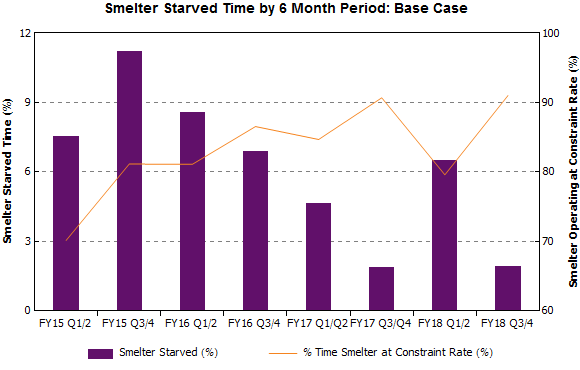I've been asked to reproduce a bar chart generated in Excel in Mathematica. The original Excel chart looks like this;

My Mathematica version looks like this;

There are a couple of things wrong that I'd like to fix;
- The
BarChartandListPlotoverlay doesn't seem to match up. - The
ChartLabelsseem to have disappeared on theBarChart. - Is there a nice way to make the ticks on the left and right sides match up (like when the Excel chart matches 9 % on the left to 90 % on the right)?
- I can't get the box and line to center align to the text in the legend.
Questions 1 and 2 are what I really need to fix, but 3 and 4 would be nice to have. Any help would be appreciated.
Here's the code I used to generate my chart;
purple = RGBColor[97/255, 16/255, 106/255];
orange = RGBColor[245/255, 132/255, 31/255];
labels =
{
"FY15 Q1/2", "FY15 Q3/4", "FY16 Q1/2", "FY16 Q3/4",
"FY17 Q1/Q2", "FY17 Q3/Q4", "FY18 Q1/2", "FY18 Q3/4"
};
starvedTime = {7.55, 11.23, 8.58333, 6.88833, 4.65167, 1.89, 6.49833, 1.95};
satTime = {70.1483, 81.1467, 81.115, 86.5483, 84.6833, 90.685, 79.6017, 91.0133};
plot1 = BarChart[starvedTime,
PlotRange -> {0, 12},
ChartStyle -> purple,
BaseStyle -> "Text",
Frame -> {True, True, True, False},
FrameTicks -> {False, True},
FrameLabel -> {None, Style["Smelter Starved Time (%)", "Text"], None, None},
PlotLabel -> "Smelter Starved Time by 6 Month Period: Base Case",
ImageSize -> Large,
ChartLabels -> {Placed[Style[#, "Text"] & /@ labels, Below], None},
AxesOrigin -> {0, 0},
PlotRangePadding -> {0, 0},
BarSpacing -> 1];
plot2 = ListPlot[satTime,
Joined -> True,
PlotRange -> {60, 100},
PlotStyle -> orange,
Frame -> {False, False, False, True},
FrameTicks -> {None, None, None, All},
FrameLabel ->
{None, None, None, Style["Smelter Operating at Constraint Rate (%)", "Text"]},
BaseStyle -> "Text",
GridLines -> {None, Automatic},
GridLinesStyle -> Directive[Gray, Dashed],
ImageSize -> Large];
box = Graphics[{purple, Rectangle[]}, ImageSize -> 12];
text = Style[" Smelter Starved (%) ", "Text"];
line = Graphics[{orange, Line[{{0, 0.5}, {1, 0.5}}]}, ImageSize -> {30, Automatic}];
text2 = Text[Style[" % Time Smelter at Constraint Rate (%) ", "Text"]];
legend = Row[{box, text, line, text2}];
Column[{Overlay[{plot1, plot2}], legend}, Alignment -> {Center, Center}]






